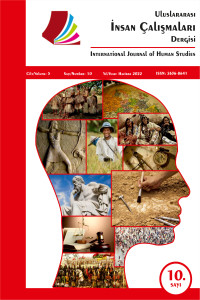Araştırma Makalesi
Yıl 2022,
Cilt: 5 Sayı: 10, 311 - 319, 31.12.2022
Öz
Şiddet, gerek bireysel hayatta gerekse toplumsal hayatta sistematik veya simgesel olarak uygulanmaktadır. Birçok farklı tanımı kapsayan şiddet olgusu bireye uygulanan fiziksel bir durumu içerdiği gibi ekonomik ve politik sistemler tarafından uygulanan her türlü zarar verici eylemleri de kapsamaktadır. Literatürde şiddet ile ilgili birçok farklı tanıma rastlamak mümkündür. Bu tanımların genel özelliği şiddeti ortaya çıkaran bireysel ve toplumsal nedenler üzerinden bir genellemeye vardıkları görülmüştür. Bu genellemelerin ortak özelliği şiddetin zarar verici negatif yönleri üzerinde yoğunlaşmış olmalarıdır. Şiddet üzerine yapılan literatür taramasında şiddet olgusunun birçok farklı yönlerinin ele alındığı ancak şiddetin keyfiliği üzerine bir boşluğun olduğu görülmüştür. Bu boşluk Arendt tarafından doldurulmuştur. Şiddetin herkesin gözü önünde ve ortalıkta olduğunu söyleyen Arendt’e göre şiddetin toplumsal ve kültürel bir tarihi vardır. Tarihte yaşanmış toplumsal olaylar üzerinden bir şiddet analizinde bulunan Arendt bu bağlamda diğer sosyal bilimcilerden farklı ve özgün bir şiddet analizi geliştirmiştir. Arendt’ın iktidar, güç ve kuvvet kavramları üzerinden geliştirdiği tanımlaması şiddetin toplumsallığına vurgu yapmaktadır. Ayrıca şiddet olgunun genişlemesi ve sistematikleşmesi için gücü elinde bulunduranların güçsüzler karşısında keyfiliğine dayandığını ortaya koymuştur. Dolayısıyla onun tanımında özellikle vurguladığı keyfilik diğer sosyal bilimcilerden ayrışmaktadır. İktidarların kendi otoritelerini ayakta tutabilmek içinde sıkça kullanılan şiddet ulus-devlet tanımlarında da devletin meşru araçlarından biri olarak kabul edilmiştir. Bu kapsamda makalede Arendt tarafından keyfilik ekseninde yeniden bir tanımlamaya gidilen şiddetin diğer sosyal bilimcilerden farklı vurguları üzerinde durulmuştur. Şiddetin biçimleri ve sınırları Arendt’in yorumları ile sınırlandırılmış ve diğer sosyal bilimcilerin tanımları ile karşılaştırılmıştır.
Anahtar Kelimeler
Kaynakça
- Arendt, H. (1997). Şiddet Üzerine. (B. Peker, Çev.) İstanbul: İletişim Yayınları.
- Audi, R. (1971). On the Meaning and Justification of Violence. Jerome A. Shaffer içinde, Violence: Award-Winning Essays in the Council for Philosophical Studies Competition (s. 45-99). New York: David McKay Company.
- Benjamin, W. (2012). Son Bakışta Aşk. İstanbul: Metis Yayınları.
- Fromm, E. (1997). Sevginin ve Şiddetin Kaynağı. (Y. S.-N. İçten, Çev.) İstanbul: Panel Yayınları.
- Sanders, B. (2010). Öküzün A'sı- Elektronik Çağda Yazılı Kültürün Çöküşü ve Şiddetin Yükselişi. İstanbul: Ayrıntı Yayınları.
- Tolstoy. (2012). Aşkın Yasası Şiddetin Yasası. İstanbul: Dedalus Yayınları.
- Weber, M. (1998). Sosyoloji Yazıları. İstanbul: İletişim Yayınları.
- Witte, B. (1999). Walter Benjamin. İstanbul: YKY Yayınları.
Yıl 2022,
Cilt: 5 Sayı: 10, 311 - 319, 31.12.2022
Öz
Violence is applied systematically or symbolically in both individual and social life. The phenomenon of violence, which covers many different definitions, includes a physical situation applied to the individual as well as all kinds of harmful actions applied by the economic and political systems. It is possible to come across many different definitions of violence in the literature. The general feature of these definitions is that they have reached a generalization over the individual and social reasons that reveal violence. The common feature of these generalizations is that they focus on the harmful and negative aspects of violence. In the literature review on violence, it has been seen that many different aspects of the phenomenon of violence are discussed, but there is a gap on the arbitrariness of violence. This gap was filled by Arendt. According to Arendtê, who said that violence is in front of everyone's eyes and around, violence has a social and cultural history. Arendt, who made an analysis of violence through social events in history, developed a unique and original violence analysis from other social scientists in this context. The definition that Arendt developed over the concepts of power, power and force emphasizes the sociality of violence. In addition, it has been revealed that the violence is based on the arbitrariness of the powerless against the powerless for the expansion and systematization of the phenomenon. Therefore, the arbitrariness he especially emphasized in his definition differs from other social scientists. Violence, which is frequently used by governments to maintain their own authority, has also been accepted as one of the legitimate tools of the state in the definitions of the nation-state. In this context, the article focuses on the different emphases of violence, which was redefined on the axis of arbitrariness by Arendt, compared to other social scientists. The forms and limits of violence are limited by Arendt's interpretations and compared with the definitions of other social scientists.
Anahtar Kelimeler
Kaynakça
- Arendt, H. (1997). Şiddet Üzerine. (B. Peker, Çev.) İstanbul: İletişim Yayınları.
- Audi, R. (1971). On the Meaning and Justification of Violence. Jerome A. Shaffer içinde, Violence: Award-Winning Essays in the Council for Philosophical Studies Competition (s. 45-99). New York: David McKay Company.
- Benjamin, W. (2012). Son Bakışta Aşk. İstanbul: Metis Yayınları.
- Fromm, E. (1997). Sevginin ve Şiddetin Kaynağı. (Y. S.-N. İçten, Çev.) İstanbul: Panel Yayınları.
- Sanders, B. (2010). Öküzün A'sı- Elektronik Çağda Yazılı Kültürün Çöküşü ve Şiddetin Yükselişi. İstanbul: Ayrıntı Yayınları.
- Tolstoy. (2012). Aşkın Yasası Şiddetin Yasası. İstanbul: Dedalus Yayınları.
- Weber, M. (1998). Sosyoloji Yazıları. İstanbul: İletişim Yayınları.
- Witte, B. (1999). Walter Benjamin. İstanbul: YKY Yayınları.
Toplam 8 adet kaynakça vardır.
Ayrıntılar
| Birincil Dil | Türkçe |
|---|---|
| Konular | Sosyoloji |
| Bölüm | Makaleler |
| Yazarlar | |
| Yayımlanma Tarihi | 31 Aralık 2022 |
| Gönderilme Tarihi | 21 Mayıs 2022 |
| Kabul Tarihi | 12 Kasım 2022 |
| Yayımlandığı Sayı | Yıl 2022 Cilt: 5 Sayı: 10 |



